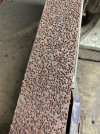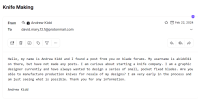- Joined
- Jul 23, 2015
- Messages
- 17,848
Good evening
B
Bigburly912
and thank you very much for the kind words! I would be happy to send you some things to cut other things with!
The BladeForums.com 2024 Traditional Knife is ready to order! See this thread for details:
https://www.bladeforums.com/threads/bladeforums-2024-traditional-knife.2003187/
Price is $300 $250 ea (shipped within CONUS). If you live outside the US, I will contact you after your order for extra shipping charges.
Order here: https://www.bladeforums.com/help/2024-traditional/ - Order as many as you like, we have plenty.
Good choiceIve come to an executive decision after scrolling through several of these pages. I need to own one (whatever the heck one means anymore…. 6 is none???) of your knives.
Fortuitous Canines!


But I have a new belt, at least for the next little while, called compact grain aluminum oxide. This belt is unbelievable. It seems to last forever. Red Label Abrasives gave me a 3 pack to try out when I talked to them about finding a 220 grit that would work better for me than the green ceramic ones, which they discontinued. The compact grain ones look like a corase grit because the individual :compact grains" of AO on them are about the size of grains of rice.
View attachment 2983546
But don't let the appearance fool you. Those grains are 220 grit, and over time, they wear away to constantly expose fresh abrasive. Because they start off relatively thick, they act kind of like a force buffer, whereas ceramic belts in this and finer grits are very thin, and as such even a slight deviation on a pass can instantly gouge a blade, requiring a frustrating trip all the way back to 120 grit. But these compact grain belts not only buffer the force, allowing for a more forgiving grinding experience, they also are much slower to build heat than those thinner ceramic 220 and higher grit belts.
Commission one! I have a marten scout with that handle and it is awesome, and even wilder when I shine a UV light on it for a couple of seconds!Its a great combination for sure. Glad it went to a good home
Commission one! I have a marten scout with that handle and it is awesome, and even wilder when I shine a UV light on it for a couple of seconds!
You are in for a treat!Welp. Excited to say there are some on the way!
Looking forward to seeing what you got!Welp. Excited to say there are some on the way!
